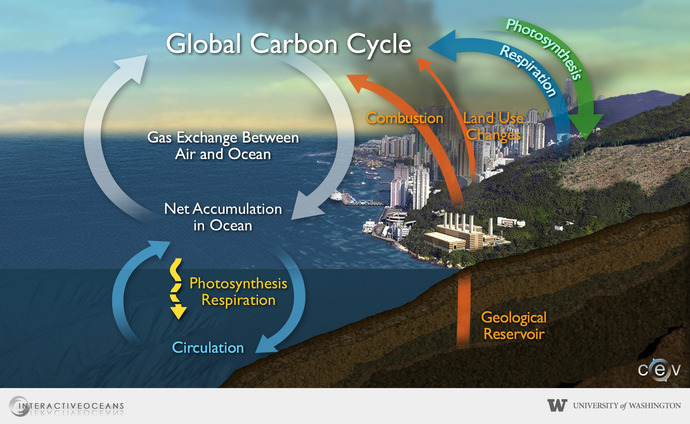Carbon Cycle

Gas exchange between the atmosphere and the oceans removes carbon dioxide and sequesters some of it for long periods of time in the deep sea.
Approximately half of all carbon dioxide emitted due to the burning of fossil fuels has ended up in the oceans. This is changing the basic chemistry of the oceans.
The oceans modulate Earth's climate, influencing crop production on the continents, the health of fisheries, and ultimately the quality of life on the planet. The oceans regulate climate in part by absorbing and storing carbon dioxide, a greenhouse gas. Gas exchange between the atmosphere and the oceans removes carbon dioxide (CO2) and sequesters some of it for long periods of time in the deep sea. The oceans are thought to have absorbed 30 to 50% of the CO2 produced by the dramatic increase in burning fossil fuels since the beginning of the industrial era 200 years ago. Without this process, CO2 levels in the atmosphere would be much higher.
Some carbon at the ocean surface is utilized by phytoplankton and zooplankton to make calcium carbonate shells or is consumed and then ejected as fecal pellets that fall and are buried on the seafloor. This so-called "biological pump" helps transport carbon from the ocean surface to the deep ocean.
However, the basic chemistry of the oceans continues to change because of the increased uptake of carbon dioxide by the oceans. This change is occurring at unprecedented rates, at least 100 times more rapidly than over the 650,000 years preceding the industrial era. Levels of carbonic acid, which forms when carbon dioxide reacts with seawater, are rising. As a result of this ocean acidification, many phytoplankton, zooplankton, and corals are being deprived of the calcium carbonate they use to build their shells and skeletons. Because these marine plants and animals form the base of the food chain in the oceans, a decline in their populations holds ramifications for everything from salmon to whales to humans.
There are many questions related to the carbon cycle in the Northeast Pacific Ocean. For example, when cold deep water upwells from the deep sea off the coast of Washington and Oregon, does it carry and release that carbon into the atmosphere or does it absorb carbon dioxide and remove it from the atmosphere. How will climate change affect this process? How do storms and variations in sea surface temperatures affect the amounts of carbon dioxide in the oceans? What are the ecosystem responses to higher concentrations of carbon dioxide and lower pH (higher acidity) in the surface waters of the Northeast Pacific? Long time-series measurements over the full water column at multiple sites along the coast and far offshore, such as those that will be made possible by the cabled observatory and Station Papa global mooring are required to answer these kinds of questions.




